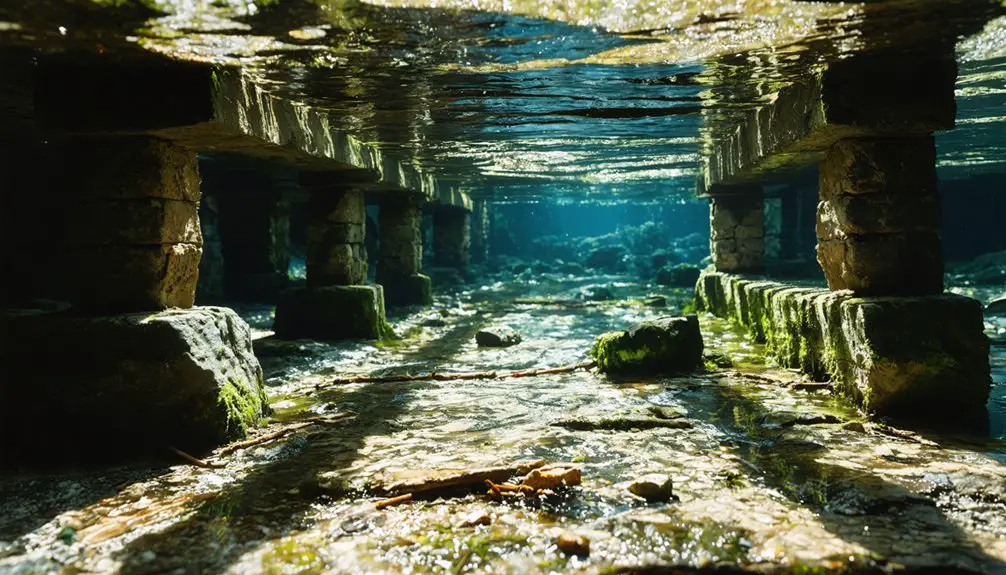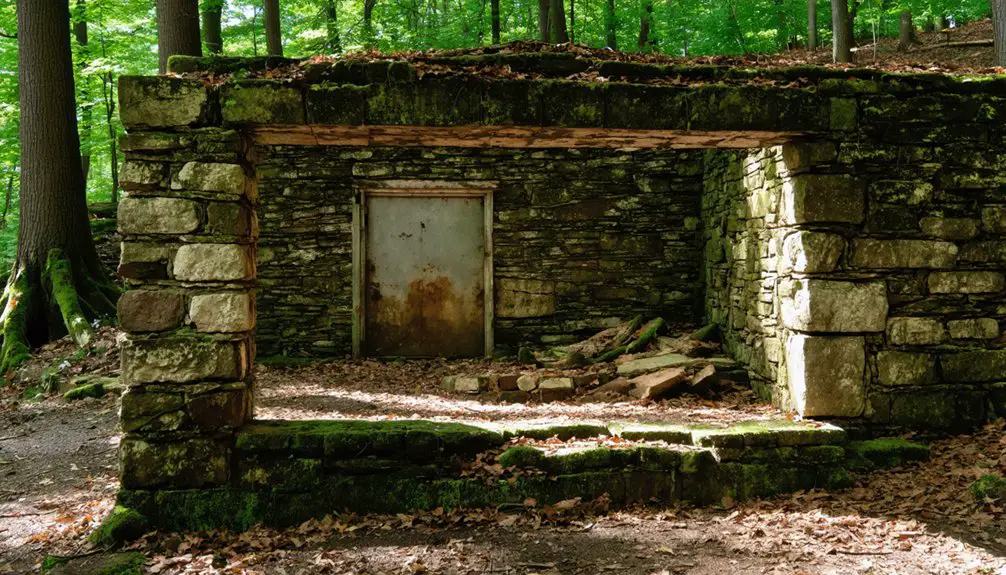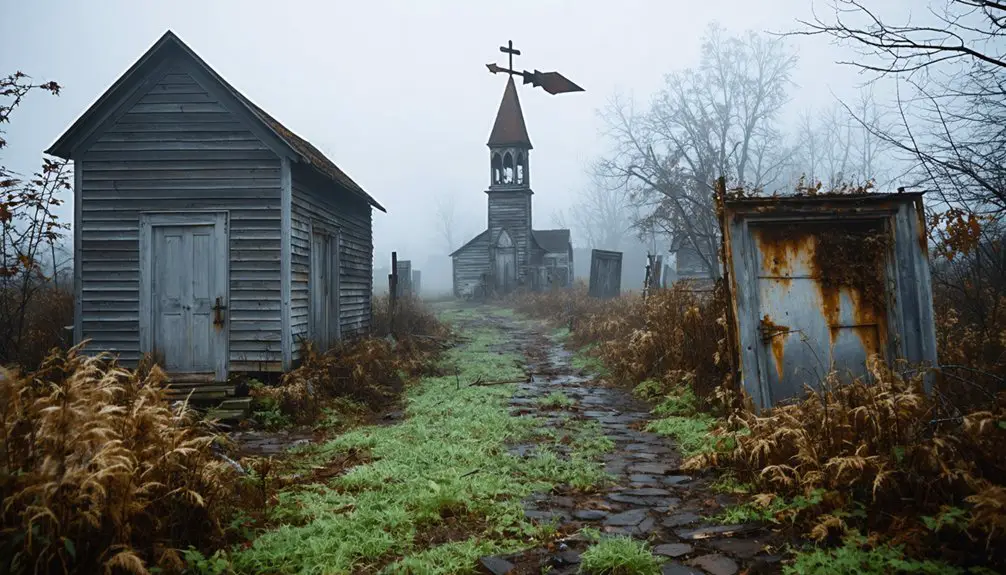You’ll find Broad Fording’s remnants in Pennsylvania’s Appalachian region, where a once-thriving coal mining town met its fate in the catastrophic flood of 1942. The community, established in the early 1800s, flourished through coal extraction and coke production, with daily outputs reaching 1,000 tons. When five feet of floodwater swept through the valley, it destroyed infrastructure and displaced residents. Today, nature reclaims the landscape while underwater sonar reveals preserved glimpses of its industrial past.
Key Takeaways
- Broad Fording transformed from a thriving 1800s mining community into a ghost town following the devastating floods of 1942.
- The town’s economy centered around coal mining and coke production, with daily outputs reaching 1,000 tons during peak operations.
- Environmental hazards, including a 1962 underground mine fire and dangerous sinkholes, made the area unsafe for habitation.
- Nature has reclaimed the abandoned town, with forests overtaking building foundations and mining infrastructure.
- Preserved artifacts and sonar surveys reveal submerged mining equipment, documenting the ghost town’s industrial past.
The Rise and Fall of a Mining Community
While coal deposits in the Broad Top Mountain region were known since colonial times, Broad Fording’s transformation into a thriving mining community began in earnest during the early 1800s. The discovery of high-quality semi-bituminous coal attracted waves of workers, showcasing remarkable community resilience as they built a new life around the mines. The mine operators implemented the traditional room-and-pillar method to extract coal efficiently from underground seams. The miners endured harsh working conditions with constant exposure to coal dust and poorly lit tunnels.
You’ll find the town’s fortunes changed dramatically with the arrival of the Huntingdon and Broad Top Mountain Railroad in 1852. This 31-mile rail connection broke shipping monopolies and sparked rapid industrial growth, with mining technology evolving from simple hand tools to mechanized coal washers and coke ovens.
However, by mid-20th century, technological shifts and market competition made Broad Fording’s traditional mining methods obsolete. The dismantling of blast furnaces, followed by equipment fires in the 1950s, marked the end of formal mining operations.
Geographic Location and Landscape
Nestled in Westmoreland County’s rugged terrain, Broad Fording stands as a reflection of Pennsylvania’s industrial past. You’ll find this ghost town in western Pennsylvania’s Appalachian region, where rolling hills and valleys define the landscape.
The area’s distinct topographical features include coal-rich underground seams and remnants of abandoned coke ovens that once fueled the region’s industrial might. As you explore the surrounding mixed hardwood forests, you’ll notice how nature’s slowly reclaiming what industry left behind. Like the infamous underground coal fire in Centralia that has burned for 60 years, the ground here bears testament to Pennsylvania’s complex relationship with coal mining. Visitors often encounter dangerous broken glass and fireworks remnants scattered across the landscape.
The landscape bears the marks of its mining heritage, with geological risks like ground subsidence from underground coal seams. Former mill races, water wheels, and mining ventilation pipes dot the terrain, while overgrown building foundations hint at the vibrant community that once called this rugged corner of the Rust Belt home.
Industrial Heritage and Economic Base
While you won’t find evidence of extensive coal mining in Broad Fording itself, the surrounding region’s coal operations notably influenced the town’s industrial development through the late 1800s.
The shift toward hot-blast technology ultimately reduced reliance on traditional charcoal iron production methods in towns like Broad Fording. Small-scale coal extraction occurred in nearby hillsides, primarily supporting local metalworking operations rather than large commercial mining ventures. Local businesses also relied heavily on water powered mills for manufacturing and processing various materials.
The presence of modest coke ovens along the railroad line suggests that Broad Fording played a supporting role in the wider region’s coal processing infrastructure, though these operations never reached the scale of Pennsylvania’s major coal districts.
Coal Mining Operations
Following the Pennsylvania Geological Survey‘s identification of rich coal deposits in 1835, Broad Fording’s transformation into a mining powerhouse began in earnest during the 1860s when Philadelphia investors acquired 8,000 acres of coal-rich land.
Mining technology centered on the room-and-pillar method, with drifts spanning 26 feet wide and 7 feet high. You’d find miners working in tight spaces, sometimes just 3-4 feet tall, using picks and shovels to extract coal. The experimental use of Broad Top coal in the 1860s by the Pennsylvania Railroad demonstrated its effectiveness as locomotive fuel. Regular mine inspections were conducted to monitor working conditions and ventilation quality.
The operation’s backbone consisted of over 400 workers who’d brave harsh conditions daily, facing constant threats from methane gas and coal dust.
Advanced ventilation systems moved 35,000 cubic feet of air per minute through the drifts, while steel rails facilitated coal transport.
Despite dangerous conditions, these mines produced 800-1,000 tons daily, powering the region’s industrial growth.
Coke Production Infrastructure
Beyond the coal mines, Broad Fording’s industrial might centered on its extensive coke production facilities, which transformed raw coal into high-grade fuel for iron furnaces across Pennsylvania.
You’d have found various coke oven designs throughout the complex, from traditional beehive ovens to Belgian rectangular models. By the 1880s, R&PC&I operated 356 ovens in the area, drawing high-quality coal from the lower Freeport seam. The coking process required precise control, with workers carefully managing dampers and sealing over 72-hour periods. The site was part of the renowned Connellsville Coalfield, known for producing premium metallurgical coal.
The site’s industrial mechanization helped optimize production, with deep wells providing pure water for proper coke quenching. These facilities weren’t just isolated industrial structures – they formed the backbone of a thriving community, complete with worker housing and essential infrastructure.
The coke produced here fueled markets as far as Chicago, powering the region’s transformation from charcoal to coke-fired blast furnaces.
Life Before Submersion
You’d find coal miners heading to work each morning in Broad Fording, their daily routines centered around the demanding schedules of underground extraction and processing.
Local businesses, from general stores to equipment suppliers, lined the main thoroughfare to serve both the mining operations and community needs.
The tight-knit social fabric wove together through shared work experiences, with miners’ families supporting each other and gathering at local establishments after long shifts underground.
Coal Mining Community Life
Life in Broad Fording revolved around the demanding rhythms of coal mining, with families and immigrant workers drawn to the region’s rich semi-bituminous coal deposits in south-central Pennsylvania.
You’d find community resilience on full display as miners faced harsh working conditions, using picks and shovels in dangerous tunnels while battling constant health risks from coal dust exposure.
Your daily life would’ve centered around mines like Wishart, Garlick, and Albert Wright, living in modest company-built homes near the mine entrances.
Despite basic infrastructure and limited amenities, cultural traditions flourished as diverse immigrant backgrounds melded into a tight-knit community.
You’d rely on company stores for necessities, while the narrow gauge Reichley Brothers Railroad connected your isolated mountain town to the outside world, transporting the coal that sustained your livelihood.
Daily Worker Routines
As dawn broke over Broad Fording, workers would begin their carefully orchestrated daily routines, traversing unpaved roads by foot or horse-drawn wagon to reach the nearby mines.
You’d join your fellow miners, sharing rides when possible, as commuting patterns followed strict shift schedules that governed the town’s rhythm.
Before heading out, you’d help with essential family chores – stoking the coal stove, gathering firewood, or tending to livestock.
Your children would prepare for school while your wife preserved food and maintained the household.
After your shift, you’d return home to share a hearty meal of home-grown vegetables and preserved meats.
Evening activities centered around the warm glow of kerosene lamps, where you’d join your family for storytelling or help with homework before retiring to rest for another day’s labor.
Local Business Activities
The bustling heart of Broad Fording’s economy revolved around its coal mining operations, established by the Locust Mountain Coal and Iron Company in 1842.
You’d find a vibrant network of businesses catering to miners and their families, from general stores stocking daily necessities to taverns serving as community gathering spots.
Local trades flourished around the mining industry, with blacksmiths, carpenters, and mechanics providing essential services.
Community markets featured fresh produce from small-scale farmers, while home-based enterprises like tailors and bakers added economic diversity.
The Reading Railroad and PA Route 61 connected these businesses to regional markets, creating a thriving commercial hub.
Supporting businesses included equipment suppliers and maintenance shops, all interconnected through a network of roads and railroad spurs that kept the town’s economy moving.
The Flooding Event
During one catastrophic week in July 1942, unprecedented rainfall pummeled north-central Pennsylvania, releasing devastating floods that would forever alter Broad Fording’s fate.
As the storm stalled over the region, rainfall rates exceeded ten inches per hour, overwhelming local waterways and defense systems.
The flooding aftermath devastated Broad Fording and nearby communities in three major ways:
- Waters rose to depths of 5 feet in central areas, sweeping buildings off their foundations.
- Rail yards and roads were destroyed, severing crucial transportation links.
- Nearly 60% of neighboring Emporium was submerged when dikes failed to hold.
Despite showing remarkable community resilience, many residents never returned after the waters receded.
The catastrophic event marked the beginning of Broad Fording’s transformation from a bustling town to a ghost town.
Archaeological Remnants Beneath the Waters

If you take a sonar survey beneath Broad Fording’s murky waters today, you’ll find the ghostly outlines of preserved mining equipment and industrial infrastructure from the town’s prosperous past.
The submerged remnants include ore processing machinery, timber support structures, and portions of the original mining railway system that once served this bustling community.
These underwater archaeological features provide essential insights into Pennsylvania’s industrial heritage, with the cold depths having preserved many technical details that would have otherwise been lost to time and the elements.
Hidden Industrial Infrastructure Found
Beneath the tranquil waters of Conemaugh River Lake lies a treasure trove of industrial archaeology, where sonar imaging has revealed an intricate network of foundational stone walls, bridge supports, and canal infrastructure from Broad Fording’s bustling past.
You’ll find hidden canals and submerged artifacts that tell the story of a once-thriving industrial hub.
The underwater landscape preserves three distinct layers of industrial history:
- Coal mining infrastructure including loading chutes and coking oven foundations
- Transportation networks featuring rail spurs and canal locks with towpaths
- Commercial structures like company stores and worker housing foundations
These remnants paint a vivid picture of the town’s evolution from canal-based commerce to rail dominance, preserved by protective layers of silt in their watery tomb.
Preserved Mining Equipment Below
A remarkable array of preserved mining equipment rests in the depths of Broad Fording’s flooded mine shafts and pits, where anaerobic conditions have considerably slowed their decay.
Through underwater archaeology, you’ll find intact rail tracks, mining carts, and hoisting machinery that tell the story of 19th and 20th-century anthracite coal mining.
You can discover these time capsules through modern technology – ROVs and sonar scanning have mapped out an extensive network of artifacts lying beneath the water’s surface.
The sediment layers have actually aided in artifact preservation by limiting oxygen exposure. While some degradation occurs, these submerged remnants provide essential physical evidence of the region’s industrial heritage.
They’re complemented by above-ground ruins, offering a complete picture of Broad Fording’s mining operations before underground fires led to abandonment.
Environmental Impact and Changes
Since the underground mine fire ignited in 1962, Broad Fording’s environmental landscape underwent catastrophic transformation.
The inferno’s intense heat, reaching over 1,350°F, triggered widespread environmental degradation and released toxic emissions that poisoned the air and soil.
Underground flames scorching at 1,350°F spewed toxic fumes into the environment, forever poisoning the landscape’s air and earth.
You’ll find the devastation’s severity reflected in these major changes:
- Ground stability collapsed, creating dangerous sinkholes and fissures that vent deadly carbon monoxide.
- Original forests disappeared, replaced by scarred terrain unsuitable for agriculture or wildlife.
- Natural hydrology shifted dramatically as steam vents altered soil composition and water flow patterns.
What you’re witnessing isn’t just environmental damage – it’s a complete ecosystem upheaval that’s transformed a once-thriving community into an unstable, hazardous zone that’ll burn for centuries to come.
Historical Documentation and Records

While historical records of Broad Fording remain particularly sparse, you’ll find the town’s documentation scattered across various regional archives and ghost town registries.
The town’s historical significance is primarily preserved through railroad documents, especially those connected to the East Broad Top Railroad system, though these references are often fragmentary.
Unlike well-documented ghost towns such as Centralia, Broad Fording faces substantial documentation challenges.
You won’t find extensive government records or relocation programs detailing its decline. Instead, the town’s story emerges through property deeds, incomplete census data, and industrial archives.
Your best sources for understanding Broad Fording’s past might be local histories and oral accounts from families in nearby communities like Neelyton, who’ve preserved memories of this once-thriving coal town.
Legacy in Pennsylvania’s Industrial History
Throughout Pennsylvania’s industrial revolution, Broad Fording emerged as a microcosm of the state’s manufacturing evolution, particularly in its strategic position along the Brandywine River.
Broad Fording’s prime location along the Brandywine River made it a vital showcase of Pennsylvania’s industrial transformation and growth.
You’ll find that industrial innovation flourished here, driven by the region’s natural resources and expanding transportation networks.
The town’s significance in regional trade and manufacturing is evident through:
- Water-powered mills that transformed from basic grain processing to diverse manufacturing, including gunpowder and paper production
- Strategic integration with Pennsylvania’s iron industry, connecting local metalworking to broader manufacturing supply chains
- Railroad infrastructure development that enabled kaolin clay mining and expanded market access
As you explore Broad Fording’s industrial heritage, you’ll discover how this once-bustling hub exemplified Pennsylvania’s evolution from resource-based manufacturing to more diverse industrial activities.
Preservation Efforts and Memory

Despite the physical decline of Broad Fording’s structures, dedicated preservation efforts have kept its memory alive through diverse archival initiatives.
You’ll find historical records, mining company documents, and land surveys carefully preserved in local societies and state archives, while oral histories from descendants capture personal narratives of life in the former mining town.
Community engagement remains strong through commemorative events, storytelling sessions, and educational programs that connect younger generations to Broad Fording’s past.
Various preservation strategies include digital archiving projects that make rare documents and photographs accessible to researchers and the public.
While nature reclaims the physical site and surviving structures face decay, virtual reconstructions and documentaries help visualize the town’s former layout.
Local museums display artifacts and images, ensuring Broad Fording’s industrial heritage endures.
Frequently Asked Questions
Are There Any Surviving Photographs of Broad Fording Before Submersion?
You’ll find it difficult to verify surviving photos, as historical documentation is scarce in public photographic archives. While some images may exist in local collections, they’re not widely accessible or digitized.
What Wildlife Species Now Inhabit the Waters Covering Broad Fording?
You’ll find bass, sunfish, and catfish swimming freely, while bullfrogs and snapping turtles demonstrate wildlife adaptation. The aquatic biodiversity includes crayfish, waterfowl, and river otters thriving in these waters.
Did Any Original Residents Relocate Together to Form New Communities?
You won’t find evidence of community migration where original residents relocated together. Historical connections suggest families dispersed individually to different areas rather than establishing new collective settlements anywhere.
Can Divers Explore the Submerged Ruins of Broad Fording Today?
You can’t dive Broad Fording’s ruins today – there’s no confirmed underwater access or documented diving opportunities. Without clear evidence of submersion and diver safety protocols, underwater exploration remains purely speculative.
Were Any Buildings or Structures Relocated Before the Flooding Occurred?
You won’t find evidence of building preservation efforts at this site. Despite potential historical significance, no records indicate any structures were relocated before flooding – they were simply abandoned to the waters.
References
- https://www.youtube.com/watch?v=Qj5LjacccJ0
- https://vocal.media/history/this-abandoned-pennsylvania-town-is-one-of-the-most-contaminated-in-the-state-sxxhe06oo
- https://www.youtube.com/watch?v=BlioLNgiKCk
- https://en.wikipedia.org/wiki/Centralia
- https://en.wikipedia.org/wiki/List_of_ghost_towns_in_Pennsylvania
- https://www.pa.gov/agencies/dep/programs-and-services/mining/bureau-of-mining-programs/pa-mining-history.html
- https://raystown.org/blog/post/coal-mining-a-hard-knock-life/
- https://jbritton.pennsyrr.com/index.php/tpm/545-huntingdon-and-broad-top-mountain-railroad
- https://tile.loc.gov/storage-services/master/pnp/habshaer/pa/pa3200/pa3208/data/pa3208data.pdf
- https://broadtopminersmuseum.com



